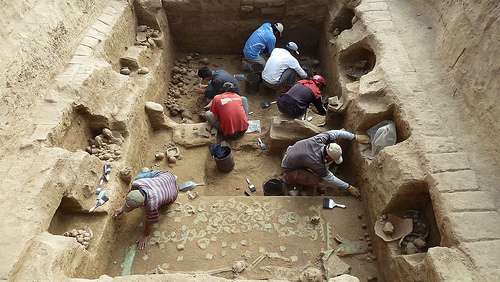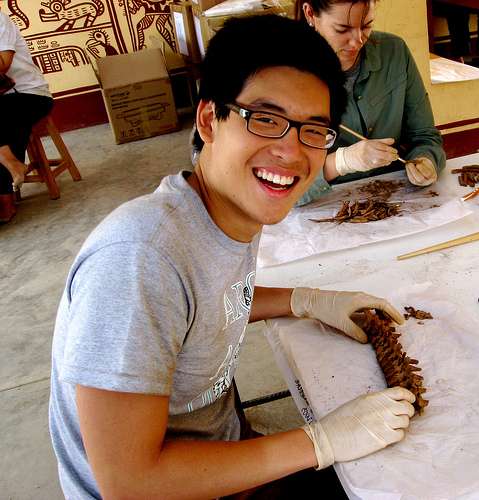Student helps discover priestess tomb

Matthew Go, a 20-year-old Simon Fraser University archaeology undergraduate student in the Faculty of Environment, can now add priestess-tomb discoverer to his list of accomplishments on his résumé.
The budding expert on human osteology—the study of human bones—was the only Canadian among nine international archaeologists who unearthed an ancient Moche priestess' chamber tomb in northwest Peru in July.
The mainly Peruvian expedition made its find while digging at the San José de Moro (SJM) Archaeological Project (SJMAP). Archaeology professor Luis Jaime Castillo at Pontifical Catholic University of Peru (PUCP) in Lima leads the 23-year-old dig.
The eighth in a cluster of approximately 1,200-year-old tombs that reveal women played a dominant role in human sacrifices in Moche society, this one contains a priestess' skeleton dated AD700-800.
She's wearing hundreds of beads, with her hands resting over two pink spondylus shells placed on her pelvis. The skeletons of two other adults and five children also occupy her tomb. Copper plates decorate her coffin.
"The tomb contains a great quantity of artifacts associated with elite status," says Go, who became the excavation team's local expert on human remains.

"This chamber is clearly one of royal proportions. Such a find gives archaeologists a glimpse into Moche social and political organization, as well as possible clues to questions about the society's sudden collapse.
"The Moche were expert craftsmen and there are still many unanswered questions that sustain this culture's enigma."
Referring to a plethora of marine-related artifacts found in the tomb, Go hypothesizes they foreshadow the Moche's collapse due to climate change.
"The chamber comes from the late Moche period, a time preceding the decline of the society," explains Go. "Most scholars believe that a mega El Niño event, which likely caused torrential rains and unpredictable changes in the environment, was one of the key causes of its demise."
Go was teaching and digging in a field school program jointly run by PUCP and Harvard University and attached to the SJMAP project when he and his colleagues made their discovery.
The Vancouverite was pursuing his second consecutive summer of research at the field school for his SFU honours thesis on spinal degenerative joint disease in Late Moche skeletons from SJMAP.
Last year, he so impressed Harvard researchers with his assessment of burials and bones that they asked him to teach and test students in this summer's field school.
When he returns to SFU this fall to pursue his fourth year of studies Go will be thanking one person in particular for helping him add discoverer status to his résumé.
It was Chris Papaianni, SFU's academic advisor for archaeology, who recommended Go check out PUCP's field school program to gain the kind of experience he sought.
"What I needed was experience dealing with human remains all the way from excavation in the field to further analysis in the lab," says Go, who is pursuing a certificate in forensic studies.
"Such an experience is hard to find in North America because the laws protecting human remains are so restrictive. Peru, on the other hand, is literally a country filthy with accessible archaeological material."
Provided by Simon Fraser University


















